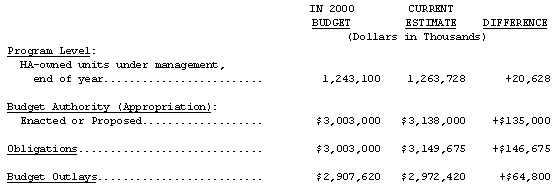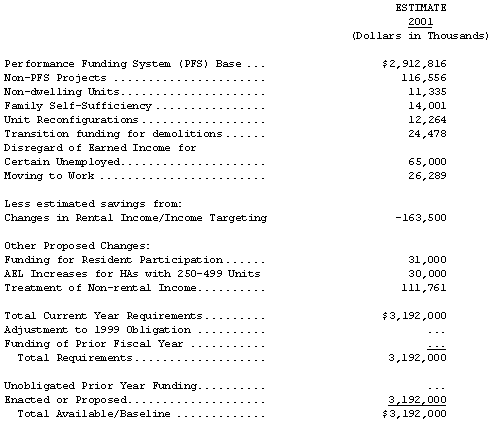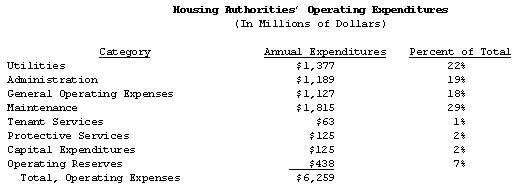 |
HUD's 2001 Budget
Congressional Justifications for EstimatesDEPARTMENT OF HOUSING AND URBAN DEVELOPMENT\
PUBLIC AND INDIAN HOUSING
PUBLIC HOUSING OPERATING FUND
PROGRAM HIGHLIGHTS

NA = Not Applicable
SUMMARY OF BUDGET ESTIMATES
- SUMMARY OF FISCAL YEAR 2001 BUDGET REQUEST
The fiscal year 2001 Budget proposes an appropriation of $3.192 billion for the Public Housing Operating Fund, an increase of $54 million over the fiscal year 2000 enacted appropriation. The request assumes full funding for Public Housing Authorities (PHAs) of their subsidy eligibility, which nationally represents 51 percent of the total operating revenues of Housing Authorities (HAs). The requested funding is expected to allow HAs to provide a reasonable level of maintenance, utilities, protective and other services to residents in fulfillment of their goal to provide decent, safe, and sanitary housing for lower-income families as required by the United States Housing Act of 1937.
This proposal reflects efforts to date to develop a new formula for the allocation of operating subsidies as required by the Public Housing Reform Act (PHRA) of 1998. To comply with the statute, in March 1999, the Department convened a negotiated rulemaking (neg reg) committee reflecting a broad range of interests which include individual HAs, national HA associations, resident organizations, and other public interest groups. The Committee is expected to issue the new formula for comment in a proposed rule on or before April 1, 2000.
Summary Of Stategic Program Objectives
The Public Housing Operating Fund is essential for achieving HUD Strategic Objectives as follows:
- Objective 1.2: making affordable rental housing available to low-income households;
- Objective 1.3: ensuring that America's housing is safe and disaster-resistant;
- Objective 3.2: enabling poor and disadvantaged families and individuals to become self-sufficient and to develop assets;
- Objective 4.2: reducing disparities in well-being among neighborhoods and within metropolitan areas; and
- Objective 4.3: keeping communities and neighborhoods safe.
As part of the Department's on-going reforms, a new evaluation and inspection system called the Public Housing Assessment System (PHAS) was implemented for HAs with fiscal years ending on or after September 30, 1999. Data collection and scoring of HAs under PHAS is performed by the Real Estate Assessment Center (REAC). PHAS will designate HAs as either high, standard, or troubled performers based on a four part evaluation of each HA, including (1) physical condition inspection, (2) financial condition, (3) management operations, and (4) resident survey of services. High performers, classified as HAs scoring 90 or higher on a 100-point scale, will be given broader management discretion. HAs scoring below 60 will be judged to be troubled performers, and will receive assistance from the Department's Office of Troubled Agency Recovery (OTAR). This assistance will improve HAs' performance to comply with the Department's standards.
- CHANGES FROM 1999 ESTIMATES INCLUDED IN 2000 BUDGET
A comparison of fiscal year 1999 actual data with estimates included in the fiscal year 2000 Budget follows:
FISCAL YEAR 1999

The number of units under management by HAs at the end of fiscal year 1999 was 2,625 higher than the estimate projected in the 2000 Budget due to a decrease in the actual number of demolitions which occurred during 1999. Obligations for fiscal year 1999 were $7.1 million less than the estimate projected in the fiscal year 2000 Budget. However, at the end of December 1999, those remaining unobligated funds were assigned and are expected to be obligated this fiscal year. Budget outlays for fiscal year 1999 were $2.876 billion, representing a $69.7 million increase over the 1999 Budget estimate reflected in the fiscal year 2000 Budget. The increase in outlays is the result of faster spend-out of fiscal years 1998 and 1999 obligations.
- CHANGES FROM 2000 ESTIMATES INCLUDED IN 2000 BUDGET
A comparison of the current estimate for fiscal year 2000 with estimates included in the 2000 Budget follows:
FISCAL YEAR 2000

HA-owned units under management (end of year) in fiscal year 2000 reflects an increase of 20,628 units over the estimate in the fiscal year 2000 Budget. This reflects fewer actual demolitions in fiscal year 1999, as well as a reduction in the demolitions projected for fiscal year 2000.
Obligations in fiscal year 2000 are estimated to increase to $3.150 billion, an increase of $146.7 million over the estimate in the fiscal year 2000 Budget due to the enactment of higher than anticipated appropriations for fiscal year 2000 plus carryover from fiscal year 1999.
Budget outlays in fiscal year 2000 are currently estimated at $3 billion, an increase of approximately $65 million over the estimate in the fiscal year 2000 Budget. The increased outlays are the primary result of the unanticipated increase of fiscal year 2000 appropriations.
EXPLANATION OF INCREASES AND DECREASES
The fiscal year 2001 Budget request of $3.192 billion represents an increase of $54 million more than the enacted fiscal year 2000 Budget of $3.138 billion. Fiscal year 2001 estimated outlays of $3.161 billion, an increase of $188.3 million over the fiscal year 2000 current estimate, reflects in part, the second year spend-out of obligations from fiscal year 1999 as well as the disbursement of obligations from 2001 funding.
The fiscal year 2001 Budget request reflects efforts to date to develop a new formula for the allocation of operating subsidies as well as the implementation of mandatory provisions in the PHRA, such as income disregards and non-rental income incentives that became effective in fiscal year 2000. New elements arising from these efforts, such as the proposed funding for resident participation activities, are described in the paragraphs that follow the table.
The table below reflects the funding for the primary elements comprising the proposed fiscal year 2001 Budget request.

Specific factors affecting the fiscal year 2001 operating subsidy estimates are:
- Economic Assumptions. The fiscal year 2001 estimates reflect the most recent assumptions about inflation, including a 2.0 percent increase in non-utility costs, and a 4.9 percent decrease in utility rates. The latter compares to a 6 percent increase in 2000. Increases in tenant income are reflected separately under "Change in Rental Income/Income Targeting." The calculation of individual HA subsidy requirements includes the use of an inflation factor which is a weighted average percentage increase in local government wages and salaries for the area in which the HA is located and non-wage expenses.
- Adjustments to Operating Subsidy Requirements. The fiscal year 2001 estimate reflects adjustments in operating subsidy requirements for various HA income and expense factors based on both existing and anticipated legislation, procedures and regulations affecting tenant rent payments and HA operating costs. These adjustments reflect the following factors:
- Non-PFS Projects. Pursuant to the PFS regulations, the PFS is not applicable to housing owned by housing authorities (HAs) in the Virgin Islands, Puerto Rico, Guam, and Alaska, and PHAs participating in a demonstration program authorized by the Congress. Operating subsidy payments to these HAs are based upon Operating Budgets approved by HUD on a case-by-case basis.
- Non-Dwelling Units. The estimate reflects additional operating subsidies for the cost of funding units removed from the dwelling rental inventory for non-dwelling use to support resident economic self-sufficiency and anti-drug programs.
- Family Self-Sufficiency (FSS). The estimate for Family Self-Sufficiency, includes the salary/benefit cost associated with the public housing share of a full-time FSS coordinator for each HA with a HUD-approved FSS Action Plan. The estimated cost also includes the subsidy of one non-dwelling unit in each FSS HA for the provision of supportive services.
- Unit Reconfigurations. The estimate for unit reconfigurations includes the costs resulting from Section 118 of the 1987 HCD Act requirement which eliminates subsidy reductions due to unit reconfigurations (breakthroughs) where the same number of people can reside in the new larger unit formed by combining two or more smaller units.
- Transition Funding for Demolitions. A provision of the PFS provides a short transition period of funding for HAs that have received approval to demolish units, and have not received replacement Section 8 certificates or vouchers. The purpose of the change is to encourage and support efforts by HAs to reduce overhead costs in a planned and orderly manner when the inventory of units is reduced by demolition.
- Earned-Income Disregard. The Public Housing Reform Act of 1998 assists families in public housing to transition from welfare to work by prohibiting rent increases which arise from employment during the 12-month period beginning on the date the employment began if the earned income increase stems from a family member who: (1) was unemployed for at least 12 months, (2) is participating in a self-sufficiency program or job training program, or (3) received welfare payments in the past 6 months.
- Changes in Rental Income/Income Targeting. The Public Housing Reform Act of 1998 provides: (1) public housing deconcentration requirements, (2) annual requirements for serving families with incomes below 30 percent of area median income, and (3) permanent repeal of Federal preferences and authorization for local preferences in public housing. Through these and other mechanisms, HAs may increase income diversity in public housing. The Department is continuing to work cooperatively with the neg reg committee to reach consensus on providing HAs with an incentive to facilitate increases in earned income by families in occupancy. Such an incentive is expected to be included in the new formula, and is reflected in the Budget.
- Funding for Resident Participation. Identified through the neg reg process, these funds will be used to support existing as well as new initiatives associated with tenant participation activities. HAs will be eligible to receive $25 per occupied unit on an annual basis for this function.
- AEL Increases for HAs with 250-499 units. A consensus of the neg reg committee was to provide smaller HAs (under 250 units) with a level of non-utility expense funding which closely approximates what FHA operating costs would be for similar projects. Although the cost associated with such a change for smaller HAs could be achieved through a redistribution of subsidies from larger HAs, the $30 million estimated for fiscal year 2001 reflects the budgetary requirement to allow this benefit to be extended to HAs that manage between 250-499 units.
- Treatment of Non-rental Income. The Public Housing Reform Act of 1998 authorizes HAs to retain non-rental income without any reduction in their operating subsidies. Effective with fiscal year 2000, however, the retained income may only be used for low-income housing or to benefit the residents of the HA. Based on HUD's accounting classification system, non-rental income is defined as interest earned on general fund investments and other income, including income from leasing of non-dwelling facilities, i.e., commercial space. Income from the rental of dwelling units used for non-dwelling purposes, e.g., a dwelling unit to a social service agency to provide program services, however, is treated as rental income.
Based on historical data, the table below represents an estimated pattern of HAs operating expenditures for fiscal year 2001. Such expenditures may vary substantially for individual authorities. This data does not reflect the impact on expenditures that may occur from recent statutory changes in the Public Housing Reform Act of 1998 or the result of the Department's current neg reg process to modify the PFS formula.

Utilities. Includes water, electricity, gas, fuel, and related labor expenses.
Administration. Includes administrative salaries, legal, expenses, staff training, travel, accounting fees, auditing fees, sundry, and outside management costs.
General Operating Expenses. Includes insurance, payments made to local governments in lieu of taxes, terminal leave payments, employees benefit contributions, collection losses, interest on administrative and sundry notes, and other general expenses.
Ordinary Maintenance and Operations. Consists of expenses for labor, materials, contracts and garbage fees associated with the day-to-day operation of the public housing authority.
Tenant Services. Covers salaries, recreation, publication, contract costs, training, and other expenses.
Protective Services. Includes expenses for labor, materials, and contract costs.
Capital Expenditures. Includes extraordinary maintenance, casualty losses and property betterments (e.g. roofs and furnaces).
Operating Reserves. Provides working capital funds, and is a cushion for emergencies.
PROGRAM DESCRIPTION
The Public Housing Operating Fund provides operating subsidy payments to approximately 3,050 Housing Authorities (HAs) with a total of over 1.2 million units under management. Operating subsidies are provided to HAs to assist in funding the operating and maintenance expenses of their owned dwellings in accordance with Section 9 of the United States Housing Act of 1937, as amended. Annual subsidy requirements have traditionally been calculated on the basis of the PFS formula which takes into account what it would cost a comparable well-managed HA to operate its units. Beginning in fiscal year 2001, operating funds will be distributed on the basis of a "new" formula developed through the current neg reg process.
The Administration proposes collecting a 1-month security deposit from all public housing residents beginning in October 1, 2000. This parallels practices in HUD's Section 8 program and in the private rental market.
FISCAL YEAR 2001 PERFORMANCE MEASURES
Four performance measures for the Public Housing Operating Fund are as follows:
- The share of public housing units that meet HUD established standards increases by 1 percent.

- The share of public housing units managed by troubled Housing Authorities decreases. Baseline to be developed in 2001.
- Increase the percentage of heads of households residing in public housing (pertains to non-elderly, non-disabled families) who derive more than 50 percent of their income from work.

- Increase the share of welfare families that move from welfare to work while residing in public housing by 1 percentage point.

The Public Housing Operating Fund also contributes to strategic outcome indicator 5.1.3�the average satisfaction of public housing tenants; 5.1.e-household-weighted average PHAS scores; 5.1.i-correct rent determinations; and 5.1.m-requirements for submission of MTCS data.
Content Archived: January 20, 2009
|